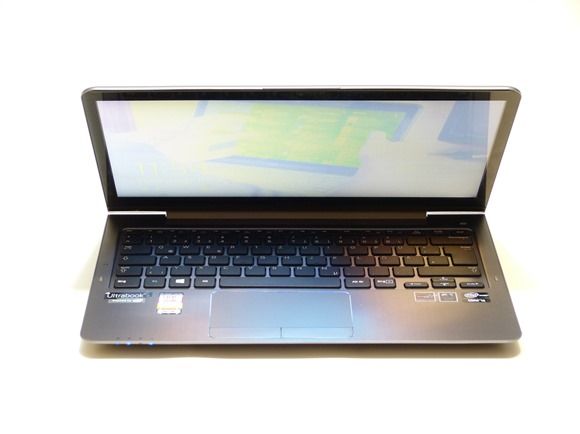
It’s always nice to review an Ultrabook that’s well-balanced and good value for money. The Toshiba U940 was one. The Samsung Series 5 (Sandy Bridge) was another. Does the Samsung Series 5 with touch, Windows 8 and SSD, have the same values? Read-on to find out.
Samsung NP540U3C Review Model Full Specs
- CPU type: Intel Core i5-3317U (Ivy Bridge, 1.7Ghz nominal)
- Graphics: Intel HD 4000
- OS: Windows 8
- Display Size:13.3-inch 1366×768
- Screen Type: LED-Backlit LCD. Glossy
- Touch Technology: 10-point Multi-touch
- Elantech Touchpad
- RAM: 8GB
- SSD: 128GB (Sandisk SSD U100 SMG2)
- Battery capacity: 51 (Wh) (54Wh capacity available in review model)
- Weight: 1635gm / 3lb 10oz (measured)
- Ports: 2xUSB2.0, 1x USB3.0 with sleep and charge, HDMI, 1xmicro VGA (adaptor supplied), Gigabute Ethernet, SD card slot, 1 x headset port.
- WiFi/BT4.0 – Centrino Advanced-N 6235
- Included accessories. Micro VGA adapter.
- No TPM Module, No VPro, Sealed battery. Access port for 7mm SATA drive, and memory slot (2GB on board), NO Keyboard backlight.
- 1MP cam. Stereo speakers. Mic.
Also available with 500GB HDD and 4GB RAM. The 128GB SSD version with 4GB RAM is available for under 900 Euro. The Core i3 version with 500GB hard drive is available for $599 in the USA. (See upgrade possibilities below.)
First Impressions.
Before we go any further it’s going to be worth us pointing out that the Series 5 with touch is almost exactly the same build as the original Samsung Series 5 (reviewed here) apart from the following.
- Larger (51Wh vs 45Wh) battery
- 10-point Touch
- 128GB SSD on the review model
- Increase in weight (about 150gm, 10%)
Apart from a plastic strip at the top of the back of the screen (to improve WiFi antenna reception?) and slightly different sized rubber feet we can’t see any differences. The Series 5 remains a stylish Ultrabook.
We’ve still got the original Samsung Series 5 here and it’s in daily use by an affiliate member of the team (my wife) so we can vouch for build quality although as with all aluminium casings, a knock can result in a highly visible dent in the casing. We have one! The original Series 5 (with HDD) here has experienced two drops and is still working perfectly though.
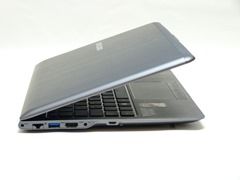
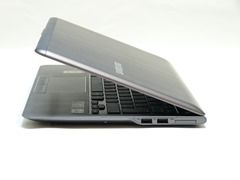
Overall the Samsung Series 5 feels well-built and looks tidy and stylish. This touch version does have a little extra weight that’s noticeable but that’s what you’ll have to accept with all touchscreen ‘retro-fit’ models.
Rear Access Port
Worth a mention is the rear access port.
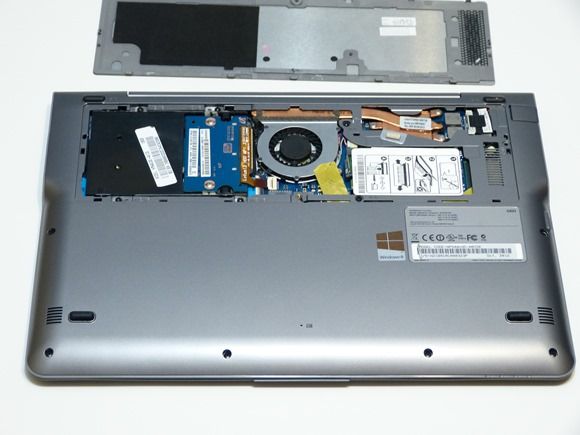
It’s easy to access and you’ll find a memory card slot (2GB resides on-board) and the 7mm-high SATA drive bay. If you need to upgrade above 128GB it’s going to be an easy operation. Given that the basic 1.8Ghz version with 500GB is only $599 in the USA, there’s potential for lower-cost of staggered upgrade. (Note that under battery power, the Turbo Boost feature is not used so the 1.8Ghz Core i3 should provide almost the same processing power as the Core i5 version when under battery power. With a 100Mhz advantage the Core i3 version may even be slightly more powerful!)
Screen, Keyboard and Mouse
As with the the original Series 5, the keyboard and mouse are good quality. Separate mouse buttons mean less stress and although the keyboard isn’t backlit, it’s of good quality. The screen, however, is possibly the weakest part of the Samsung Series 5 Ultra Touch. The touch layer means it’s a glossy unit and unfortunately it’s not an IPS wide-viewing angle panel. Colors and brightness are good. As for the resolution, 1366×768 is not what we’d expect on an Ultrabook at the current price. This will be a deal breaker for some although if it’s screen real-estate you want, maybe a bigger screen should be on your list. (The Samsung Series 9 15” does the business in that respect.)
Performance
Overall the SSD performance is good (not the best in class) and the 1.7Ghz Ivy Bridge CPU will give you solid performance for any sort of office work. There’s one issue to note in that Turbo Boost is disabled under battery power. As with the original Series 5 it’s tuned to be ‘polite.’ that means no big heat build-up or fan noise. There’s even a silent mode where the fan is turned down, or even off in some cases.
Note: Remember to turn the Quiet Mode off as it locks the CPU to 800Mhz
Boot speed is about as fast as you can get today with sub 25 seconds easily achieved.
Audio Performance
With Analogue headset output, HDMI and WiDi you’ve got analogue, digital and wireless digital output. There’s no array mic. Speaker quality isn’t bad for a laptop.
Video (external)
HDMI and VGA output (via a mini port which requires the supplied adaptor) have you covered for most projectors and screens up to 1080p resolution. WiDi will also give you that wirelessly if you buy a $50 adaptor box but there’s no DisplayPort here for higher resolutions.
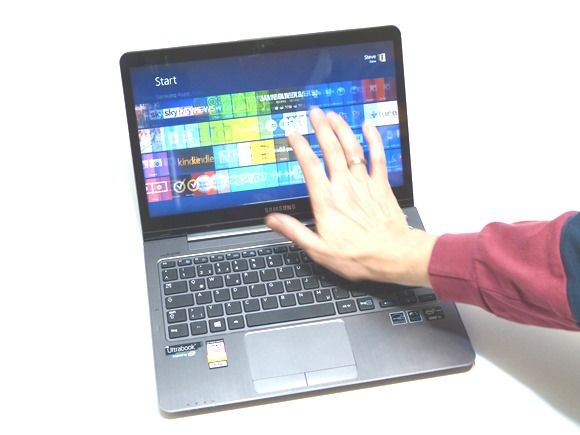
Video (Internal GPU)
The HD 4000 GPU is a great step up from the HD 3000 of the previous generation Samsung Series 5 and brings it into the realm of casual gaming. The Intel Quick Sync video hardware has also been speeded up so for those wanting to convert video files with a compatible program, you’ll see excellent results. With the SSD in place of the hard drive even consumer video editing at 1080p is possible.
Disk Speeds and CrystalDiskMark
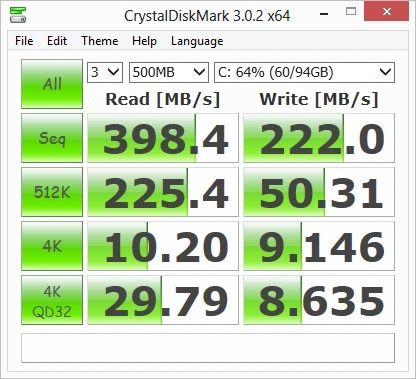
The SSD speed results are reasonable although not as fast as some SSDs we’ve tested recently. Compared to the hard drive version of the Samsung Series 5 we tested last year the speeds are many, many times faster.
3DMark 06

Previous results:
- 3DMark 06 – Dell Inspiron 15z (Core i5, GT630M) – 7772
- ASUS Taichi 21 (Core i5, 128GB SSD, balance battery mode) – 4658
- Dell XPS 12 (Core i7 at 1280×800) 3DMark = 4837
- Lenovo Ideapad Yoga 13 (Core i7) = 4506
- Lenovo Thinkpad Twist (Core i5, mains power – balanced performance mode @ 1280×768 resolution) = 4023
- Lenovo ThinkPad X1 Carbon (Core i7 at 1280×800) = 5224
- Samsung Series 9 2012 15” (Core i5 3317U, balanced battery mode) = 5112
- Lenovo U300S (Core i7 SB 1.7Ghz) high performance battery power: 3520, mains power: 3611
- Samsung Series 5 (Core i5 SB 1.6Ghz) Battery power – high performance mode: 3416
PCMark 7
Fujitsu Stylistic Q702 PCMark7 score: 3782

Previous Results
- Dell Inspiron 15Z (Core i5, GT630M) – 2642
- ASUS Taichi 21 (Core i5, 128GB SSD, balance battery mode) – 4522
- Dell XPS 12 (Core i7) PCMark7 = 4895
- Lenovo Ideapad Yoga 13 (Core i7) = 4615
- Lenovo Thinkpad Twist (Core i5, mains power – balanced mode) = 3386
- Lenovo ThinkPad X1 Carbon (Core i7) = 4832
- Samsung Series 9 2012 15” (Core i5 3317U, balanced battery mode) = 3129
- Lenovo U300s (Core i7 SB, 1.8Ghz) PCMark 3280
- Samsung Series 5 (Core i5 SB, 1.6Ghz) PCMark: 1894 (high performance, battery power.)
Cinebench 11.5 CPU Test (2 Core)
Samsung Series 5 Ultra Touch Cinebench CPU test – 1.71 (Turbo Boost not available in battery powered state)
Previous results
- Dell Inspiron 15Z (GT630m) – 2.33
- ASUS Taichi 21 (Core i5, 128GB SSD, balance battery mode) – 2.24
- Dell XPS 12 (Core i7) = 2.7
- Lenovo Ideapad Yoga 13 (Core i7) = 2.23
- Lenovo Thinkpad Twist (Core i5) = 2.34
- Lenovo Thinkpad X1 Carbon(Core i7) = 2.55
- Samsung Series 9 2012 15” (Core i5 3317U, balanced battery mode) = 1.68
- Lenovo U300S (Core i7 SB): 2.12 points
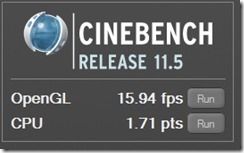
Cinebench 11.5 OpenGL
Cinebench 11.5 OpenGL Samsung Series 5 Ultra Touch SSD – 15.94
Previous results
- Dell Inspiron 15Z (GT630M) – 23.58
- ASUS Taichi 21 (Core i5, 128GB SSD, balance battery mode) – 14.22
- Dell XPS 12 (Core i7) = 15.23
- Lenovo Yoga 13 (Core i7) = 13.44
- Lenovo Thinkpad Twist (Core i5) – 10.73
- Lenovo Thinkpad X1 Carbon (Core i7, battery balanced) = 13.73
- Lenovo ThinkPad X1 Carbon (Core i7, mains, max performance) = 15.03
- Samsung Series 9 2012 15” (Core i5 3317U, balanced mains mode) = 15.63
- Lenovo U300s (Core i7 SB 1.7Ghz) high performance mode : 8.68
Battery Life
Samsung usually do a good job on platform efficiency and we can confirm that the Series 5 Ultra Touch SSD follows that trend and with the 51Wh battery (ours came with 54Wh of charge capacity) some above-average battery life figures can be achieved. In one extended test we did we confirmed that you could write, while offline, on the Samsung Series 5 Ultra Touch for 10 hours on one charge. More details on that test can be found in the separate article here.
In general, for online activities including using web-based applications and strong WiFi connectivity you’ll be OK for around 6hrs of browsing. Video playback should net you around 4hrs and for gaming, if you should choose to do so, you’ll be looking for a charge after around 2-2.5 hours depending on the intensity of the game.
Heat / Noise
The Samsung Series 5 never gets noisy although you can hear the fans and feel the warmth underneath when under load. Considering the heavy tendency towards throttling the CPU back from high Turbo clockrates one gets the impression that Samsung have configured the Series 5 Ultrabook towards quiet work scenarios and longer battery life. Recovery
Stability and Quality
We had one niggling fault during testing. Often, after a standby session, the touchscreen didn’t respond. Going into standby and returning again often fixed this. It could be software related although we made sure we had all driver and firmware updates in place.
Support Ultrabooknews and detailed reviews.
YoPlease take the time to promote us on your favorite social networks if you feel this review was useful. It helps us to keep standards high.
Target Customer
Just one year ago it would have been impossible to buy a touch and SSD Ultrabook for the $850 that is being asked today but it’s not the only option in the market. Samsung have created a very high quality Ultrabook though and given the ports, battery life and working facia we can see this being popular among a wide range of customer types. The Sam sung Series 5 Ultra Touch will replace a 3-year old desktop well, provide good on-the road battery life, a comfortable typing and mouse experience and will look good at the same time. Maybe it’s easier to highlight the customers that the the Samsung Series 5 will not work for…
Those looking for higher resolution (for clearer fonts or, with reduced text size, more working space) and those looking for wide viewing angles won’t like the Samsung Series 5. Likewise the people that want full-power on-the-go. The locked Turbo Boost under battery power is there to give a cooler, quieter and longer-running experience.
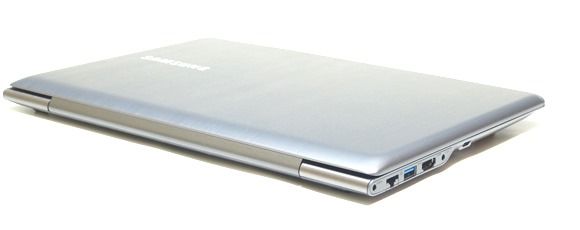
Summary
If we had an editors award we’d be giving it to the Samsung Series 5 Ultra Touch right now because it’s a well-built, well engineered and good looking Ultrabook that can handle many duties well. There’s the possibility of upgrading SSD and memory and the touchscreen adds fun and productivity. A good set of ports with a full-size SSD card slot completes the line-up. If Samsung had thrown in a 1600×900 screen the package would be near perfect. But that’s possibly what the new Samsung Series 7 Ultrabook is there for so as that feeds in to the market, look for pricing offers on the Series 5 Ultra Touch. At $849 it’s already good value but we feel that there’s at least $100 to be had in offers later this year. As a back-to-school Ultrabook as the new Haswell-based Ultrabooks feed in, this could be become 2013’s best mainstream Ultrabook.
Our tip: To save money or to have a lower entry-point into this Ultrabook look for offers on the Core i3 version which, under battery power will match the Core i5 for performance. Upgrade the 500GB drive to an SSD and drop in some more memory when you’ve got the money. The Core i3 version is currently available for $599 in the USA.

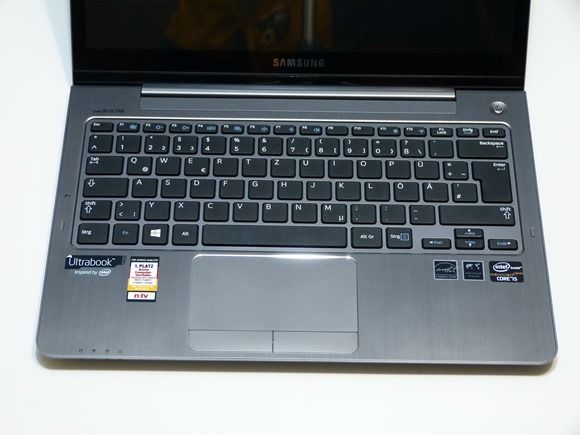










The perfect ultrabook to buy on the cheap ($599 hd version) and upgrade to a high perf SSD.
Great review; seems to be a great device too.
Thanks for a good balanced review. I suggest you also provide a table showing the pros and cons. Makes it easy for not so IT savvy persons.